The special symptoms of pancreatitis are characterized by a more extensive diagnostic model and should be diagnosed as a complex. Based on medical recognition and high effectiveness, they were all named after their authors.
Record content:
-
1 Clinical picture
- 1.1 Symptoms
- 1.2 Causes
-
2 Symptoms investigated by the authors
- 2.1 Voskresensky
- 2.2 Mayo-Robson
- 2.3 Kerte
- 2.4 Razdolsky
- 2.5 Mondor
- 2.6 Kacha
- 2.7 Cullen
- 2.8 Gray Turner
- 3 Other copyright techniques
-
4 Recommendations for using symptomatic diagnostics
- 4.1 Oral examination
- 4.2 Diagnostics of the abdomen
- 5 Video about pancreatitis
Clinical picture
Pancreatitis is a complex of various diseases. or symptomatic manifestations that appear due to inflammatory processes in the pancreas. Inflammation is characterized by the absence of the release of enzymes and the presence of destruction of the organ itself. In severe cases, toxic substances are released into the bloodstream, causing damage to the heart, kidneys, brain, or liver.
In medical practice, it is customary to adhere to the basic classification of pancreatitis, which differs based on the nature
course and symptomatic manifestations:- spicy;
- chronic;
- acute recurrent;
- exacerbation due to the development of chronic pancreatitis.
Often, chronic classification is a consequence of an acute type of pancreatitis. The differences between the acute course of the disease and the exacerbation are conditional, because their manifestations are characterized by the onset of pain syndrome six months after development.
The nature of the lesion of the pancreas differs in the volume of pathological manifestations or the presence of tissue necrosis. So, there are 2 types of progressive disease: edematous and destructive. If the first is characterized by a single tissue damage without the formation of whole foci, then the destructive is characterized by the size of necrotic islets.
Symptoms
The clinical symptoms of chronic and acute pancreatitis are different. Often, after a cured disease, pseudocysts appear in the gland, which leads to a chronic course.
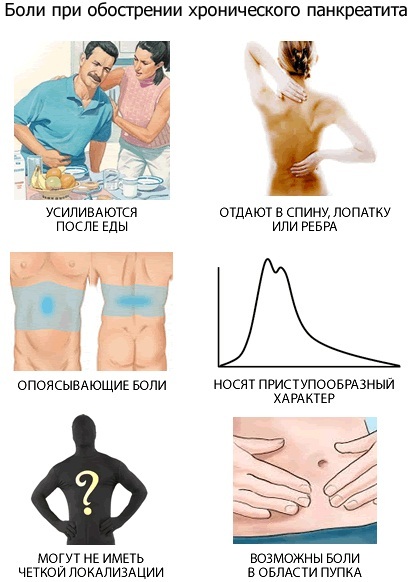
Common manifestations of pancreatitis include:
- frequent pain in the stomach;
- constant or sudden pain in the upper abdomen;
- the presence of vomiting interspersed with bile;
- irradiation radiating to the left;
- a rapid increase in temperature and blood pressure;
- tachycardia;
- prolonged diarrhea and constipation;
- decrease in body weight and a general decrease in appetite;
- pallor, dryness, or yellow skin tone;
- development of hypovitaminosis and anemic diseases.
Pancreatitis is characterized by two stages - exacerbation and remission. Recurrent symptoms are associated with changes in dietary rules, alcohol abuse, or stressful situations.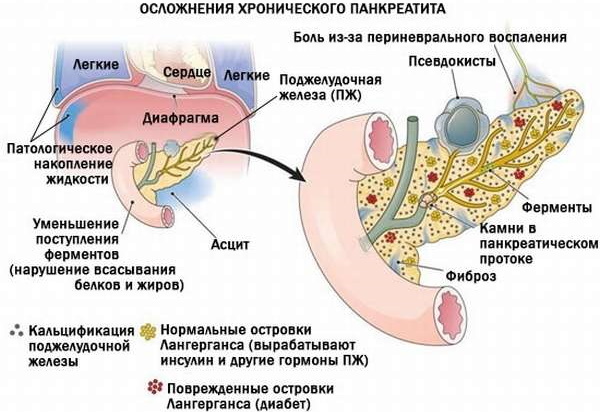
Since signs of the disease can appear in the diagnosis of pathological processes such as a heart attack, ulcerative formations or attacks of appendicitis, a complex differential measurement should be carried out well-being.
Causes
The first classification of the chronic course of the disease appeared in 1946. With her help, the occurrence of pancreatitis due to alcohol consumption was described. In the mid-60s. updated signs of pathology have been created, which indicated the relationship of pancreatitis with the following factors:
- pathology in the gallbladder. The presence of stones, surgery, dyskinesia, as well as non-compliance with certain preventive and health-improving methods, lead to the development of an acute form;
- diseases of the gastrointestinal tract. Pathological processes such as colitis, duodenitis, gastritis or ulcers are the most common causes of pancreatitis;
- diseases of the spleen and liver such as hepatitis and cirrhosis of the liver;
- allergy. The presence of various allergic reactions can lead to the development of acute inflammatory processes, which occurs due to the increased production of toxic components in the blood;
- infectious infections. Diseases of a viral or infectious nature lead to the gradual destruction of the walls of the gland. The most common are influenza or viral hepatitis.
Since overeating leads to an increased production of gastric juice, the gland begins to work many times stronger, producing even more acidic substance. This affects the development of inflammatory processes in nearby tissues or organs.
Research indicates a direct relationship between the occurrence of disease and the presence of parasitic organisms, frequent consumption of foods high in fat, or when taking certain types of medical drugs. Also, pathology can develop as a result of injury in the abdomen.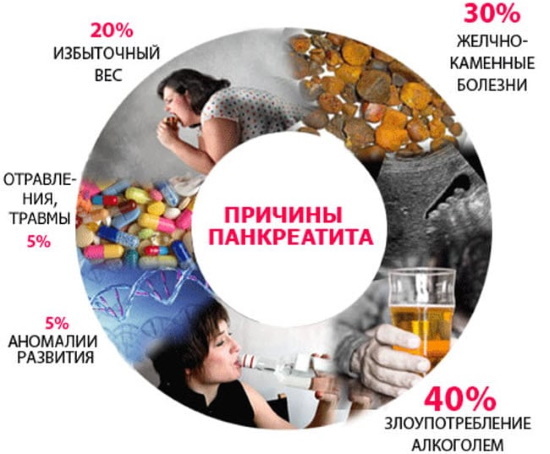
Hereditary predisposition, characterized by structural features of the pancreas or nearby organs, can also contribute to the development of pancreatitis.
Symptoms investigated by the authors
According to the authors, the symptoms of pancreatitis are the definition of a complex of pathological manifestations that allow more accurately diagnose and draw up a treatment plan to eliminate signs or cure diseases.
The course of pancreatitis varies from mild, in which pathological phenomena can go away on their own, to severe - with the risk of rapid death. Based on this, a timely assessment of the severity of the disease is a particularly important measure to avoid negative manifestations.
In addition to diagnostics based on the author's symptoms, the following clinical examination systems are used in practice:
- Ranson criteria;
- APACHE II and Glasgow system;
- results of computed tomography.
Based on the general symptoms, diagnostic methods may be ineffective, which is why the use of a complex of author's methods is the best option for the rapid detection and treatment of pancreatitis.
Voskresensky
Voskresensky's symptomatic manifestations, also called false insensitivity, is a fundamental diagnostic method that is especially popular in practice.
The essence of the technique is palpation of the lower abdomen. In the absence of inflammatory processes, the attending physician does not detect pulsations in the abdominal region, where the main aorta intersects with the pancreas.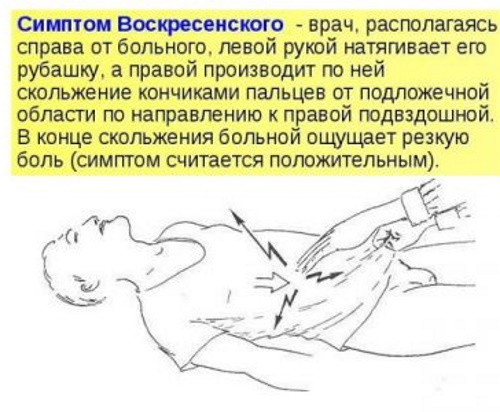
The symptomatology of Voskresensky is carried out as follows:
- The doctor stands to the right of the lying patient.
- With the left hand, tension is created on the clothing.
- With the other hand, a sliding movement is carried out with light pressure on the abdomen.
- Subsequent palpation actions are aimed at finding the pulse from the lower part of the ribs.
The rate of pulsating manifestations is 5 cm higher. from the navel and to the left by 4 cm. from its center. Deviations are explained by the swelling of the gland and its rapid increase, which leads to overlapping of the aorta.
If a patient suffers from an acute course of the disease, he has increasing pain, which is explained by the presence of various inflammatory processes in certain areas of the body.
You cannot rely only on the signs of Voskresensky, because similar symptoms can be detected in the presence of cancers, flatulence or enlarged lymph nodes
Despite the fact that such a diagnosis can be carried out on your own, only a qualified specialist who is guided not only by knowledge, but also by experience can make the correct diagnosis.
Mayo-Robson
According to the authors, the symptoms of pancreatitis became especially popular in the middle of the 20th century, when the accompanying diagnostic equipment had not yet been developed. Such methods are used now, due to the ease of execution and the absence of expensive equipment.
The Mayo-Robsant palpation method is named after the surgeon from England who invented the technique. Also, the doctor was engaged in the study of pathological processes inside organs, including the pancreas.
Its application is characterized by several stages:
- Determine the starting point A, which is in the middle area.
- Find point B at the site of the navel.
- Use an imaginary line to connect 2 points.
- Divide the plot into 3 equal parts mentally.
- The point that will be between 2 and 3 parts is the right place for diagnostics.

If there is a lesion in the tail of the pancreas, the patient will feel severe radiating pain radiating to the abdominal region or back. If pathological phenomena are present in other departments, there will be no pain with Mayo-Robson's symptoms.
Kerte
Symptomatic manifestations of Kerte are characterized by the presence of severe pain on palpation of an area located 5 cm. higher from the navel. The pain radiates to the back, often accompanied by the entire abdomen.
Kerte's syndrome allows you to objectively assess the presence of pathological formations or destruction of the main part of the pancreas. It is often used to diagnose diseases of the appendix.
The technique is characterized by good compatibility with all other symptomatic techniques, due to which it is used in combination. A single application can detect acute pancreatitis in only 40% of cases.
Razdolsky
The symptoms of pancreatitis according to Razdolsky differ from other authors in the specifics of their implementation. So, the doctor performs tapping in the area of the pancreas. The method is especially effective in severe disease, when inflammatory processes affect the entire peritoneum.
For the most obvious manifestation of symptoms, tapping can be performed in conjunction with palpation. In addition to fingers, the doctor may use other tools such as rubber hammers or pumps.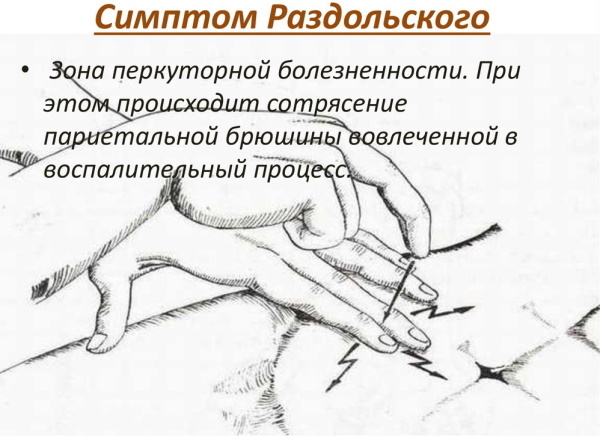
The technique is the most effective for determining the area of maximum sensitivity. In addition to pancreatitis, it is also effective in detecting symptoms of peritoneal irritation, which may be due to cancers, gastritis, or ulcers.
Mondor
The acute course of pancreatitis using Mondor's symptoms makes it possible to detect the disease in 80% of cases. The doctor palpates almost all areas of the skin, which is aimed at identifying dark blue cyanotic spots, which can appear due to high intoxication.
In practice, the so-called "Mondor Triad" is used - symptomatic manifestations characterized by:
- tension of the muscular skeleton in the abdomen;
- irritation of the abdominal cavity;
- the presence of abnormalities in the pulse on palpation.
The triad can be used for perforation of ulcers, gastritis history or muscle tension due to trauma or any other pathological processes.
Given the general symptomatology of pancreatitis, the Triad reveals the disease in 90% of cases, indicating concomitant pathological changes in the body.
Kacha
Kacha's symptoms are characterized by the presence of painful sensations on palpation of the thoracic spine, in particular 8-11 transverse processes of the vertebra. Radiating pain is characterized by increased sensitivity and return to the left side.
It is also carried out in the diagnosis of hyperesthesia of the innervation area, including all segments of the thoracic region. Reveals painful sensations characteristic of the acute course of the disease, in which pathological processes are able to pass to other organs.
Comprehensive diagnostics is characterized by the use of symptomatic techniques aimed at palpating the external muscle of the abdominal region on the right side. Differs in the appearance of a painful cord from the costal arch to the edge of the rectus abdominis muscle. The symptom can persist up to 1 month after the elimination of the main signs of an acute course.
If the patient has a special parenchymal form of the disease, Kach's symptoms will be characterized by hyperesthesia of the entire skin, which is characterized by hypersensitivity.
Cullen
Cullen's symptoms are characterized by the presence of icteric spots in the navel. Indicates the development of intoxication of the body, as well as pathological skin disorders.
Painful manifestations occur due to hypovolemia - a decrease in the volume of blood circulating through the veins. It is characterized by a low heart rate, which occurs due to the pathologically caused pressure of the diastolic type. Also, with a severe course of the disease, the patient's perfusion decreases.
The occurrence of hypovolemia is characterized by increased dry skin, febrile manifestations, changes in facial features. Airway diagnostics detect abnormalities such as shortness of breath and metabolic acidosis. In the absence of comprehensive treatment measures, respiratory syndrome may develop.
The increase in heart rate is about 110-120 beats per minute. Many patients experience intense pain in the region of the heart, the presence of hypotension. Untimely assistance can lead to the development of a hypovolemic shock state.
Diagnostics of the digestive organs, the effectiveness of which is impaired due to the acute form of pancreatitis, indicates increased dry mouth, all mucous membranes, as well as white plaque on the tongue. Palpation of the abdomen, as a rule, is characterized by uniform distension and high pain.
Cullen's symptoms are characterized by a decrease in urine volume by 4-5 times from the norm - up to 250-400 ml. per day. Peritoneal signs can extend to the entire peritoneal cavity.
Gray Turner
Gray-Turner's symptomatology indicates the development of hemorrhagic manifestations, which are manifested due to the appearance of blue spots in the left abdomen. In the presence of intoxication, the spots can give a yellow tint.
The history is often characterized by such signs as the presence of alcoholism, allergic reactions, and substance abuse. All this to a large extent provokes the development of an acute form of pancreatitis. It also includes the constant use of fatty foods and medications that can cause spasms in the area of the pancreatic sphincter.
Gray-Turner's manifestations often indicate the presence of cholecystopancreatitis - a complex of inflammatory processes in the region of the gallbladder and the gland itself. The main signs of such a pathological reaction are complaints of hepatic colic. In this case, painful sensations often spread to the area of the left hypochondrium.
Other copyright techniques
Symptoms of pancreatitis by the authors, in addition to the most famous names, contains the following techniques with which you can conduct a timely differential diagnosis of the patient.
| Symptoms named by author | Symptoms |
| Lagerlef | Cyanosis of the face, general intoxication, pathology of the respiratory tract |
| Küllen | Cyanotic spots of a yellow tint in the navel area |
| Levy | Dilated pupils, dry mouth, impairment of the normal functioning of the cardiovascular system |
| Chukhrienko | Painful sensations of the epigastric region and iliac region |
| Roving | Pain and tremors with volumetric palpation of the abdomen |
| Chuguev | Feeling of muscle tension in the external muscle of the abdominal cavity, which is detected when lying on the left side |
Additional diagnostic methods include procedures such as a complete blood count, urine test, and the study of various biological markers, in particular electrolyte levels.
The purpose of instrumental studies includes an ultrasound scan, which can indicate the development of pancreatitis in 70% of cases. For diagnosis, laparoscopy and procalcitonin testing are also often used.
The severity of the disease is assessed based on the Ranson criterion, in which the doctor indicates the total scores, the number of which determines the subsequent treatment. Also, patients with identified pancreatitis are examined by a resuscitator.
Recommendations for using symptomatic diagnostics
According to the authors, the symptoms of pancreatitis require correct diagnostic measures. If the research is carried out poorly, there is a high chance of causing additional harm to the patient.
Oral examination
On examination of the oral cavity, the tongue should be of a natural size, without swelling or plaque marks. It is characterized by a velvety texture, good moisture content and no cracks or ulcers.
The soft palate is normal pink in color, without plaque, blood, or ulcers. The color of the tonsils is physiological, natural. The size is not increased, without purulent formations.
Diagnostics of the abdomen
The shape of the abdominal cavity should be natural, without asymmetry. The abdomen is actively involved in the process of breathing, opening freely and evenly. The navel and groin areas are normal - no hernias or bulging. The navel itself does not differ in moisture. There should also be no swollen saphenous veins on the abdomen. The skin color does not have cyanotic areas.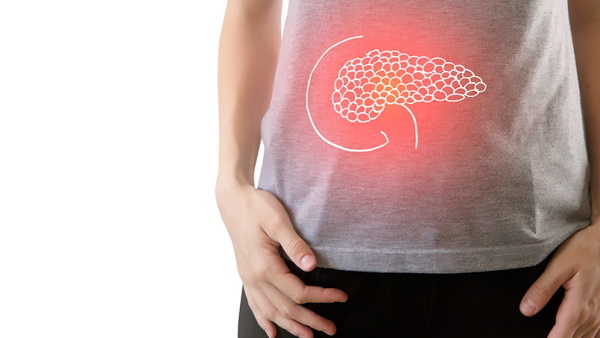
Palpation of the abdomen is divided into the following types:
- superficial. Painful sensations appear only in the hypochondrium. There is no pain in the appendicular points, based on the diagnosis by the authors. Nodes, seals, tumors, as well as roughness or enlargement of organs are not detected;
- deep. The curvature of the stomach is felt in the form of a soft fold, which does not give off painful sensations. Its thickness is 1 cm. in diameter;
- deep on Strazhesko. On the left side of the ileum, the sigmoid colon is palpable without pain, no rumbling, and dense texture. Physiological thickness is 3 cm. with mobility in the region of 2 cm.
For the general picture, the urinary organs can be examined, the diagnosis of which is carried out using the methods of percussion, palpation or preliminary examination of the lumbar zone.
In addition to the general manifestations, the symptoms of any type of pancreatitis indicate the presence of signs of the disease, deduced by numerous authors. This not only helps to correctly diagnose the pathology, but also to prescribe the most effective treatment.
Video about pancreatitis
Treatment + diet for pancreatitis:



